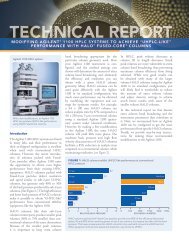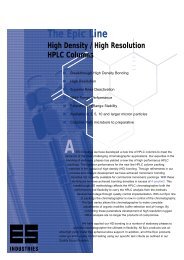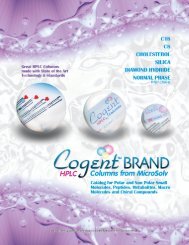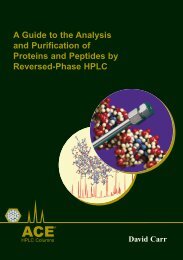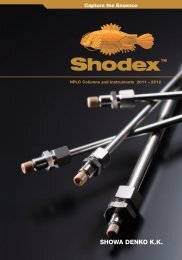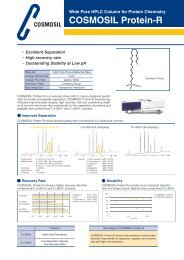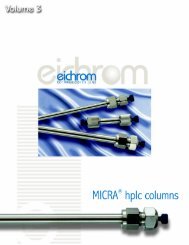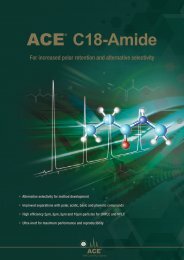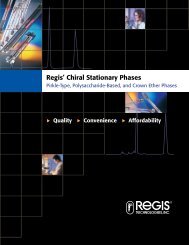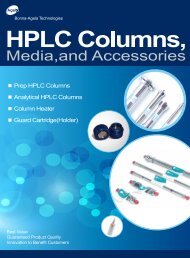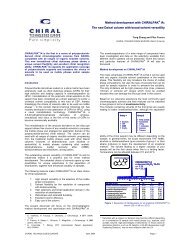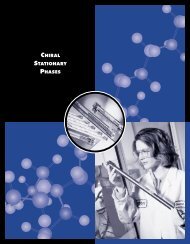A Guide to HPLC & LC-MS Buffer Selection - by John W ... - Hplc.eu
A Guide to HPLC & LC-MS Buffer Selection - by John W ... - Hplc.eu
A Guide to HPLC & LC-MS Buffer Selection - by John W ... - Hplc.eu
You also want an ePaper? Increase the reach of your titles
YUMPU automatically turns print PDFs into web optimized ePapers that Google loves.
eached. This buffer will be more concentrated than the equimolar blend, but the<br />
target pH should be correct (within the pH meter limits).<br />
Finally, the improper technique of buffer preparation should be cited. This is <strong>to</strong><br />
adjust the pH after organic solvent is added. Although it is possible <strong>to</strong> obtain a pH<br />
reading with organic solvent present [5-7], it cannot be compared directly <strong>to</strong><br />
aqueous pH measurements, so the numeric value of the pH is not very<br />
meaningful. This technique also is more susceptible <strong>to</strong> other fac<strong>to</strong>rs (e.g.<br />
%-organic, temperature) than the other methods of buffer preparation and<br />
therefore should be avoided.<br />
Although, for most methods, it will not matter if you prepare buffer <strong>by</strong> weight,<br />
equimolar blending, or titration with concentrated acid, some methods will be<br />
sensitive <strong>to</strong> the subtle differences. For this reason, it is important <strong>to</strong> include a<br />
statement of the buffer preparation technique in the documentation for a<br />
method.<br />
Precautions<br />
To consistently obtain high-quality results, a few techniques should be practiced<br />
routinely. First, use the best reagents available – most buffer components are<br />
available in <strong>HP<strong>LC</strong></strong> grade. <strong>Buffer</strong> purity is more important for gradient elution<br />
separations than isocratic ones. Some reagent-related problems become more of<br />
an issue as the detection limits are lowered. This is illustrated in Figure 5 [8].<br />
One way of checking for impurities is <strong>to</strong> run a non-injection, blank gradient. In<br />
the case of Figure 5a, the baseline showed several peaks larger than 10 mAU.<br />
For an assay with peaks of 0.8 <strong>to</strong> 1 AU in size range, such noise would be of<br />
little concern, but for this application, the sample contained peaks of 5-10 mAU<br />
that required quantification. Dirty blank gradients, as in Figure 5a, typically<br />
point <strong>to</strong> problems due <strong>to</strong> dirty water or reagents. However, in this case, the<br />
problem was isolated <strong>to</strong> the method of buffer preparation. If the pH was<br />
checked <strong>by</strong> dipping the pH meter probe in<strong>to</strong> the bulk mobile phase, the results<br />
of Figure 5a were typical. An alternative procedure – removing an aliquot of<br />
mobile phase, checking its pH, and then discarding the aliquot – yielded the<br />
blank gradient shown in Figure 5b. You can see that the pH probe was the<br />
primary source of the extra peaks in the run of Figure 5a. For maximum<br />
sensitivity runs, particularly at UV wavelengths of



